Governments and WHO face pressure to ban commercial trade in wild animals, but experts say this would criminalise a way of life for millions of people
CAPITALISM IS THE TECHNOLOGICAL ADVANCEMENT IN FARMING WHICH ELIMINATES THE COMMONS OF THE SMALL FARMER, AND DRIVES THE GROWTH OF CAPITALIST INDUSTRIES IN THE CITIES
Animals farmed is supported by
 About this content
About this contentJohn Vidal
Tue 26 May 2020 07.15 BSTLast modified on Wed 27 May 2020 12.30 BST
Shares
325
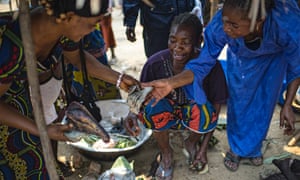
Jeanne Mwakembe and Bernardette Maselé selling bushmeat (crocodile and antelope) at the Moutuka Nunene market in Lukolela, Democratic Republic of Congo. Photograph: Ollivier Girard/CIFOR
Antelope is best, monkey is chewy, bats needs a sauce, forest porcupine is mild, and pangolin – one of the most trafficked animals in the world – tastes great roasted but smells awful. That, at least, was what the Gabonese workers told us.
We were in a Belgian-owned logging camp in Gabon. The day had been spent watching giant trees being felled for the Chinese market but by evening everyone’s thoughts had turned to food.
Most rural Africans and Asians say “bush” or wild meat is healthier, tastier and often cheaper than the bland meat of most farmed animals like chickens or pigs. The joke among the African loggers in the camp that night was that Asians would eat anything alive in the forest but the squeamish Europeans would eat nothing.
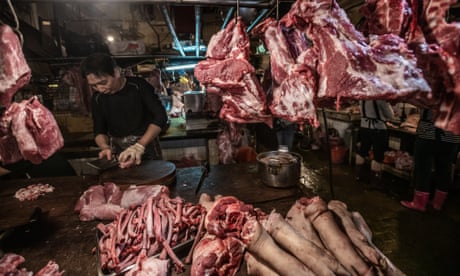
‘Mixed with prejudice’: calls for ban on ‘wet’ markets misguided, experts argue
https://www.theguardian.com/environment/2020/apr/15/mixed-with-prejudice-calls-for-ban-on-wet-markets-misguided-experts-argue-coronavirus
Today, as a result of Covid-19 and its suspected origins in a Chinese “wet” market, governments and the World Health Organization are coming under growing pressure from conservationists, vegans, and animal protection, zoo, and welfare groups to not just stop the hunting of all wild animals for food but to end the commercial trade in live animals with a global ban. Now is the time to link human health with biodiversity loss and animal suffering and to close all markets selling live or dead wild animals, they say.Q&A
What is a wet market?Show
A spokeswoman for WWF UK says: “We have called for the closure of illegal and unregulated wildlife markets, primarily in urban areas. What we are concerned about is the illegal consumption of highly threatened wildlife, often seen as a delicacy.”
There is no doubt that wild meat hunting and consumption is heavily impacting the world’s wildlife, giving rise to what is called “the empty forest”, where few large mammals remain. A 2016 Royal Society paper shows that the bushmeat trade is growing fast, with devastating results. “As wildlife populations outside protected areas decline, poaching pressure is increasing in many parks and reserves,” say the authors. “As a consequence many forests, savannahs, grasslands and deserts in the developing world are now becoming ‘empty landscapes’ devoid of harvest-sensitive wild mammals.”
What has changed over 50 years, say scientists, is the scale of the commercial wild meat trade. In the past, local subsistence hunters killed animals in small numbers. Today a high-volume industry supplies fast-expanding Asian and African cities. No longer run by local hunters, it is helped by modern firearms and cellphones, and utilises a vast network of new roads driven deep into forest concessions by the international logging industry. Hunters can strip a forest or wetland in a few nights and access home and export markets for their meat. And as the forests are emptied of their animals, the price of wild meat soars and it becomes a luxury commodity for urban elites.
Antelope is best, monkey is chewy, bats needs a sauce, forest porcupine is mild, and pangolin – one of the most trafficked animals in the world – tastes great roasted but smells awful. That, at least, was what the Gabonese workers told us.
We were in a Belgian-owned logging camp in Gabon. The day had been spent watching giant trees being felled for the Chinese market but by evening everyone’s thoughts had turned to food.
Most rural Africans and Asians say “bush” or wild meat is healthier, tastier and often cheaper than the bland meat of most farmed animals like chickens or pigs. The joke among the African loggers in the camp that night was that Asians would eat anything alive in the forest but the squeamish Europeans would eat nothing.

‘Mixed with prejudice’: calls for ban on ‘wet’ markets misguided, experts argue
https://www.theguardian.com/environment/2020/apr/15/mixed-with-prejudice-calls-for-ban-on-wet-markets-misguided-experts-argue-coronavirus
Today, as a result of Covid-19 and its suspected origins in a Chinese “wet” market, governments and the World Health Organization are coming under growing pressure from conservationists, vegans, and animal protection, zoo, and welfare groups to not just stop the hunting of all wild animals for food but to end the commercial trade in live animals with a global ban. Now is the time to link human health with biodiversity loss and animal suffering and to close all markets selling live or dead wild animals, they say.Q&A
What is a wet market?Show
A spokeswoman for WWF UK says: “We have called for the closure of illegal and unregulated wildlife markets, primarily in urban areas. What we are concerned about is the illegal consumption of highly threatened wildlife, often seen as a delicacy.”
There is no doubt that wild meat hunting and consumption is heavily impacting the world’s wildlife, giving rise to what is called “the empty forest”, where few large mammals remain. A 2016 Royal Society paper shows that the bushmeat trade is growing fast, with devastating results. “As wildlife populations outside protected areas decline, poaching pressure is increasing in many parks and reserves,” say the authors. “As a consequence many forests, savannahs, grasslands and deserts in the developing world are now becoming ‘empty landscapes’ devoid of harvest-sensitive wild mammals.”
What has changed over 50 years, say scientists, is the scale of the commercial wild meat trade. In the past, local subsistence hunters killed animals in small numbers. Today a high-volume industry supplies fast-expanding Asian and African cities. No longer run by local hunters, it is helped by modern firearms and cellphones, and utilises a vast network of new roads driven deep into forest concessions by the international logging industry. Hunters can strip a forest or wetland in a few nights and access home and export markets for their meat. And as the forests are emptied of their animals, the price of wild meat soars and it becomes a luxury commodity for urban elites.
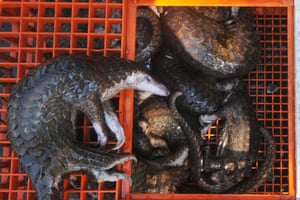
Dead pangolins seized by authorities in Belawan, North Sumatra. More than 5,500 species of birds, mammals, amphibians and reptiles are bought and sold on the worldwide animal market. Photograph: Gatha Ginting/AFP via Getty Images
Sue Lieberman, vice-president of international policy at the New York-based Wildlife Conservation Society, says that growing populations in Africa and Asia must switch to eating farmed animals. “People do need other sources of food [than bushmeat]. I am not saying that people should not eat wild animals [but] there is not enough to go round any more. Commercialisation is the problem. The first priority must be to stop the commercial markets. They can’t go on. Practices that originated hundreds of years ago have to stop. The amount it would cost to provide chicken and farmed fish to everyone [in Africa] is negligible compared to what this pandemic is costing.”
But critics of a ban say that the legal wildlife meat trade employs hundreds of thousands of people, provides protein for between 30 million and 70 million people in Africa alone and kills few threatened, or rare animals.
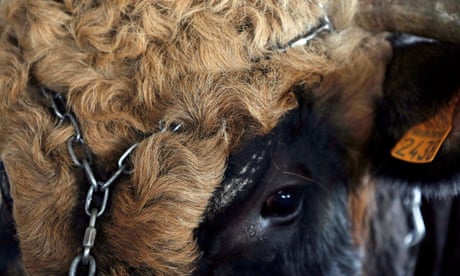
What about the environmental impacts of farming? According to a major 2011 study led by Robert Nasi, director general of the Center for International Forestry Research (Cifor), a switch to cattle to provide protein in place of wild animals would have huge impact.
Hunters, says Nasi, take about 4.5m tonnes of bushmeat a year from forests in the Congo basin and possibly 1.299m tonnes in the Amazon. “We would need to transform large areas of tropical forests or savannas into pasture to replace [this amount of] bushmeat by cattle. For comparison, Brazilian beef production is considered responsible for about 50m hectares [124m acres – twice the size of the UK] of deforestation. If bushmeat consumption in the Congo basin was to be replaced by locally produced beef, an area as large as 25 m hectares might have to be converted to pastures.”
Factory farming has devastating effects on wildlife, says Philip Lymbery, director of UK-based Compassion in World Farming. “It is a main driver of wildlife decline and the destruction of the world’s remaining wild lands,” he says. “It’s about keeping animals caged in sheds, which sounds efficient but you have to devote vast areas of land to grow their feed. It drives encroachment into wild lands and the destruction of habitats.
“It would cause unimaginable suffering to the animals, and even more environmental devastation. It would also create the perfect breeding ground for the next pandemic. Factory farming and pandemics are strongly linked. The main driver of future pandemics will be factory farming.”
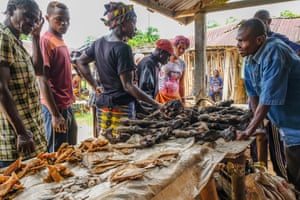
Bushmeat on sale at the weekly market in Yangambi, DRC. The animals that are hunted include warthogs, monkeys and Gambia rats. Forests in the area still have plenty of animals although numbers have declined over the past decade. Photograph: Axel Fassio/CIFOR
Many epidemiologists, ecologists, human rights and indigenous peoples’ groups say a knee-jerk global reaction to ban the wild meat trade could be unscientific, counter-productive and culturally offensive.
The western conservation “industry” wants an end to the eating of wild animals because it wants vast new areas of land to be “protected” in the name of increasing biodiversity, says Fiore Longo, advocacy officer of Survival International.
“But this model of ‘fortress conservation’ is dangerous,” she says. “Conservationists have seized the crisis as a chance to criminalise the ways of life of a large part of the world’s population. It reinforces the false divide between people and wildlife, and potentially vastly increases the size of protected areas whatever the human cost may be.
“What happens if we outlaw the trade and consumption of wildlife where there are no other sources of protein available? Do we let more people starve? Is a dependence on industrial food production with all its enormous environmental, health and financial impacts somehow ‘better’ than the sustainable consumption of wild animals?”

In Guyana, bushmeat is sold freely in a variety of places including restaurants, bars, private homes or on the roadside. People hunt and trade wild meat for food, income or just as a hobby. The most commonly traded species include capybara and iguana.
Photograph: Manuel Lopez/CIFOR
“It is important not to throw the baby out with the bathwater,” says John Fa, coordinator of the Bushmeat Research Initiative at Cifor. “Wild meat plays an important role in the nutrition of large populations of humans, accounting for up to 50% of the protein intake of people in central Africa. You can’t just say to people: ‘You can’t do it any more.’”
Wildlife hunting bans mostly fail, says Stephanie Brittain, who spent five years in Cameroon researching bushmeat consumption and now works with Oxford University’s Interdisciplinary Centre for Conservation Science. After the 2013–16 Ebola outbreak in west Africa, she says, bans were brought in by several countries but could not be policed. The result was a marked increase in hunting for wild meat. “There [is] no conclusive evidence that banning the wildlife trade will prevent the emergence of zoonotic diseases in the future,” she says. “The legal trade for species that can be safely harvested can facilitate improved hygiene and animal welfare, while complete bans can drive trade underground, resulting in illegal markets with lower hygiene regulation and increased risk of disease transmission.”
As for the idea that disease is more likely to accompany wild meat, experts point out that illnesses like Mers and Sars, BSE, swine and bird flu, E coli, MRSA and salmonella, originated in intensive poultry, pig and livestock farms where the overuse of antibiotics and unhygienic conditions can spread disease quickly. Many are common. According to the OIE, the World Organisation for Animal Health, there are currently more than 25 outbreaks of H5 and H7 avian flu having to be controlled in more than 20 countries, including the US, Germany, India and Saudi Arabia. Any one, if unattended by vets, could develop into an epidemic.
“Intensive farming is an area that must also be looked at”, says Eric Fevre, chair of veterinary infectious diseases at Liverpool University. “As we select for better milk cows, better beef cows or better egg-laying chickens, we create populations of animals that often live in intensive conditions, but where the genetics are very similar. This creates risks for [the] emergence of diseases, because if these genetically uniform large populations are susceptible, things can spread very quickly.
”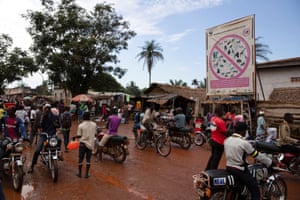
In Congo, part-time hunters boost their income with bushmeat. A WWF billboard listing protected species at the entrance of a bushmeat market in Mbandaka, DRC.
Photograph: Thomas Nicolon/Reuters
Delia Grace, programme leader for food safety and zoonoses at the International Livestock Research Institute, said: “Wet markets are basically fresh food markets. In the UK we like farmers’ markets with fresh cornfed chickens, farm-sourced meats and nice looking sausages. That’s basically a wet market, though in a different cultural context. They are essential to bring fresh food to urban populations, and provide for the food security of millions of people.
“They do need to be regulated and controlled. They should not be blanket banned, as that is not sensitive to the needs of their clients who depend on them.”
Conservationists are struggling to diminish consumption of wild animals through behaviour campaigns, legislation and law enforcement – especially in urban

In Congo, part-time hunters boost their income with bushmeat. A WWF billboard listing protected species at the entrance of a bushmeat market in Mbandaka, DRC.
Photograph: Thomas Nicolon/Reuters
Delia Grace, programme leader for food safety and zoonoses at the International Livestock Research Institute, said: “Wet markets are basically fresh food markets. In the UK we like farmers’ markets with fresh cornfed chickens, farm-sourced meats and nice looking sausages. That’s basically a wet market, though in a different cultural context. They are essential to bring fresh food to urban populations, and provide for the food security of millions of people.
“They do need to be regulated and controlled. They should not be blanket banned, as that is not sensitive to the needs of their clients who depend on them.”
Conservationists are struggling to diminish consumption of wild animals through behaviour campaigns, legislation and law enforcement – especially in urban
No comments:
Post a Comment